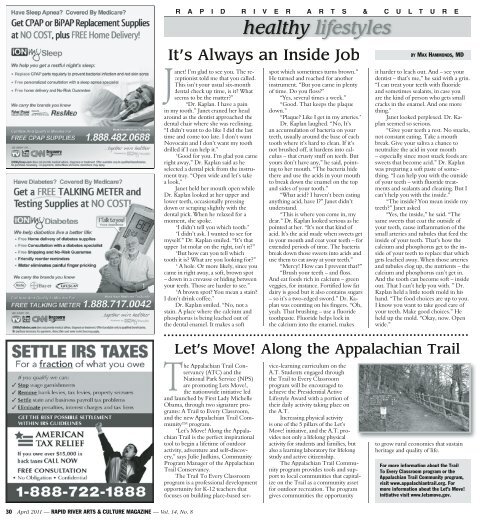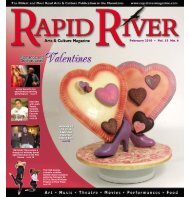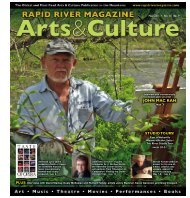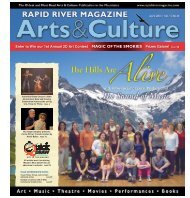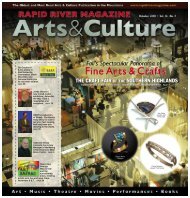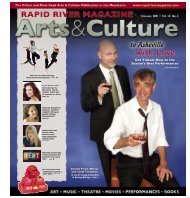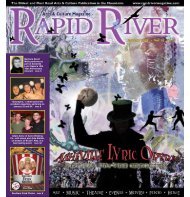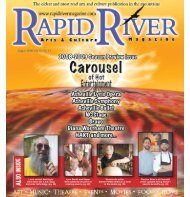JONAS GERARD - Rapid River Magazine
JONAS GERARD - Rapid River Magazine
JONAS GERARD - Rapid River Magazine
Create successful ePaper yourself
Turn your PDF publications into a flip-book with our unique Google optimized e-Paper software.
R A P I D R I V E R A R T S & C U L T U R E<br />
healthy lifestyles<br />
It’s Always an Inside Job<br />
Janet! I’m glad to see you. The receptionist<br />
told me that you called.<br />
This isn’t your usual six-month<br />
dental check up time, is it? What<br />
seems to be the matter?”<br />
“Dr. Kaplan. I have a pain<br />
in my tooth.” Janet craned her head<br />
around as the dentist approached the<br />
dental chair where she was reclining.<br />
“I didn’t want to do like I did the last<br />
time and come too late. I don’t want<br />
Novocain and I don’t want my tooth<br />
drilled if I can help it.”<br />
“Good for you. I’m glad you came<br />
right away,” Dr. Kaplan said as he<br />
selected a dental pick from the instrument<br />
tray. “Open wide and let’s take<br />
a look.”<br />
Janet held her mouth open while<br />
Dr. Kaplan looked at her upper and<br />
lower teeth, occasionally pressing<br />
down or scraping slightly with the<br />
dental pick. When he relaxed for a<br />
moment, she spoke.<br />
“I didn’t tell you which tooth.”<br />
“I didn’t ask. I wanted to see for<br />
myself.” Dr. Kaplan smiled. “It’s that<br />
upper 1st molar on the right, isn’t it?”<br />
“But how can you tell which<br />
tooth it is? What are you looking for?”<br />
“ A hole. Or more likely, since you<br />
came in right away, a soft, brown spot<br />
– down in a crevasse or hiding between<br />
your teeth. Those are harder to see.”<br />
“A brown spot? You mean a stain?<br />
I don’t drink coffee.”<br />
Dr. Kaplan smiled. “No, not a<br />
stain. A place where the calcium and<br />
phosphorus is being leached out of<br />
the dental enamel. It makes a soft<br />
spot which sometimes turns brown.”<br />
He turned and reached for another<br />
instrument. “But you came in plenty<br />
of time. Do you floss?”<br />
“Yes, several times a week.”<br />
“Good. That keeps the plaque<br />
down.”<br />
“Plaque? Like I get in my arteries.”<br />
Dr. Kaplan laughed. “No, It’s<br />
an accumulation of bacteria on your<br />
teeth, usually around the base of each<br />
tooth where it’s hard to clean. If it’s<br />
not brushed off, it hardens into calculus<br />
– that crusty stuff on teeth. But<br />
yours don’t have any,” he said, pointing<br />
to her mouth. “The bacteria hide<br />
there and use the acids in your mouth<br />
to break down the enamel on the top<br />
and sides of your tooth.”<br />
“What acid? I haven’t been eating<br />
anything acid, have I?” Janet didn’t<br />
understand.<br />
“This is where you come in, my<br />
dear.” Dr. Kaplan looked serious as he<br />
pointed at her. “It’s not that kind of<br />
acid. It’s the acid made when sweets get<br />
in your mouth and coat your teeth – for<br />
extended periods of time. The bacteria<br />
break down those sweets into acids and<br />
use them to eat away at your teeth.”<br />
“Mercy! How can I prevent that?”<br />
“Brush your teeth – and floss.<br />
And eat foods rich in calcium – green<br />
veggies, for instance. Fortified low fat<br />
dairy is good but it also contains sugars<br />
– so it’s a two-edged sword.” Dr. Kaplan<br />
was counting on his fingers. “Oh,<br />
yeah. That brushing – use a fluoride<br />
toothpaste. Fluoride helps lock in<br />
the calcium into the enamel, makes<br />
BY MAX HAMMONDS, MD<br />
it harder to leach out. And – see your<br />
dentist – that’s me,” he said with a grin.<br />
“I can treat your teeth with fluoride<br />
and sometimes sealants, in case you<br />
are the kind of person who gets small<br />
cracks in the enamel. And one more<br />
thing.”<br />
Janet looked perplexed. Dr. Kaplan<br />
seemed so serious.<br />
“Give your teeth a rest. No snacks,<br />
not constant eating. Take a mouth<br />
break. Give your saliva a chance to<br />
neutralize the acid in your mouth<br />
– especially since most snack foods are<br />
sweets that become acid.” Dr. Kaplan<br />
was preparing a soft paste of something.<br />
“I can help you with the outside<br />
of your teeth – with fluoride treatments<br />
and sealants and cleaning. But I<br />
can’t help you with the inside.”<br />
“The inside? You mean inside my<br />
teeth?” Janet asked.<br />
“Yes, the inside,” he said. “The<br />
same sweets that coat the outside of<br />
your teeth, cause inflammation of the<br />
small arteries and tubules that feed the<br />
inside of your teeth. That’s how the<br />
calcium and phosphorus get to the inside<br />
of your teeth to replace that which<br />
gets leached away. When those arteries<br />
and tubules clog up, the nutrients – the<br />
calcium and phosphorus can’t get in.<br />
And the tooth can become soft – inside<br />
out. That I can’t help you with. ” Dr.<br />
Kaplan held a little tooth mold in his<br />
hand. “The food choices are up to you.<br />
I know you want to take good care of<br />
your teeth. Make good choices.” He<br />
held up the mold. “Okay, now. Open<br />
wide.”<br />
30 April 2011 — RAPID RIVER ARTS & CULTURE MAGAZINE — Vol. 14, No. 8<br />
Let’s Move! Along the Appalachian Trail<br />
The Appalachian Trail Conservancy<br />
(ATC) and the<br />
National Park Service (NPS)<br />
are promoting Lets Move!,<br />
the nationwide initiative led<br />
and launched by First Lady Michelle<br />
Obama, through two signature programs:<br />
A Trail to Every Classroom,<br />
and the new Appalachian Trail Community<br />
TM program.<br />
“Let’s Move! Along the Appalachian<br />
Trail is the perfect inspirational<br />
tool to begin a lifetime of outdoor<br />
activity, adventure and self-discovery,”<br />
says Julie Judkins, Community<br />
Program Manager of the Appalachian<br />
Trail Conservancy.<br />
The Trail To Every Classroom<br />
program is a professional development<br />
opportunity for K-12 teachers that<br />
focuses on building place-based service-learning<br />
curriculum on the<br />
A.T. Students engaged through<br />
the Trail to Every Classroom<br />
program will be encouraged to<br />
achieve the Presidential Active<br />
Lifestyle Award with a portion of<br />
their daily activity taking place on<br />
the A.T.<br />
Increasing physical activity<br />
is one of the 5 pillars of the Let’s<br />
Move! initiative, and the A.T. provides<br />
not only a lifelong physical<br />
activity for students and families, but<br />
also a learning laboratory for lifelong<br />
study and active citizenship.<br />
The Appalachian Trail Community<br />
program provides tools and support<br />
to local communities that capitalize<br />
on the Trail as a community asset<br />
for outdoor recreation. The program<br />
gives communities the opportunity<br />
to grow rural economies that sustain<br />
heritage and quality of life.<br />
For more information about the Trail<br />
To Every Classroom program or the<br />
Appalachian Trail Community program,<br />
visit www.appalachiantrail.org. For<br />
more information about the Let’s Move!<br />
initiative visit www.letsmove.gov.


